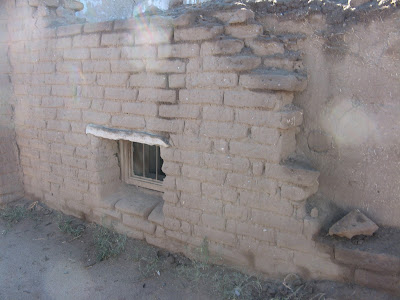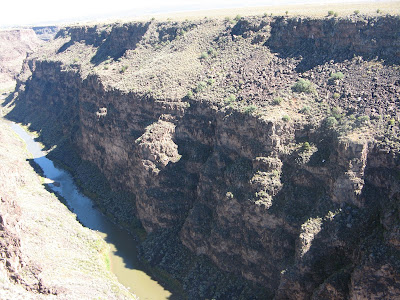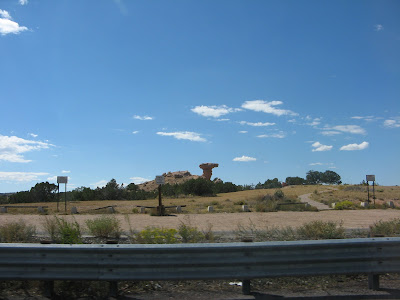Views en route.
Chimayo is our first stop and we park in the parking area near the entrance to the Santuario de Chimayo. This place seems like a mini Lourdes or Knock. It is set beneath the Sangre de Cristo Mountains. The spot where the church was built was also a sacred place to the early Indians of the area.
This is the three cultures monument which depicts the meeting of a Native America, a white cowboy and a Hispanic vaquero under a benevolent figure of the Virgin Mary.
Some time around 1810 a Chimayo friar was doing penance when he saw a light bursting from a hillside. Digging he found a crucifix, which became called the miraculous crucifix of Our Lord of Esquipulas. A local priedt brought the crucifix to Santa Cruz but 3 times it disappeared and was found back in its hole. By that it becamr understood that El Senor de Esquipulas wanted to remain in Chimayo. A small chapel was built on the site and then the miravulous healings began. These grew so numerous that the chapel had to be replaced by a larger and now the current shrine. The crucifix is still on the chapel altar but for some reason its curative powers have been overshadowed by El Posito, the "sacred sand pit" from which the crucifix sprang. A sign asks people/children not to play in it because it is sacred. A prayer room, next door to the sacristy where the sacred sand pit is, is filled with discarded crutches and braces - a bit voodoo like. No photos allowed.
There are several churches in Chimayo
And lots of art/souvenir shops
An altar for outdoor masses.
This is Our Lady of La Vang, the saint of Vietnam. She was erected here in 2011 in honour of Vietnamese refugees.
We took ourselves off in search if coffee and were successful, even getting 2 cookies (a type of shortbread with star anise). The owner is a woodcarver, his sister paints religious scenes and makes the cookies. The owner also makes his own chile powder and we were persuaded to buy, following a sample of his medium blend. We then bought crushed chiles in another shop. They are big jim chiles (appropriate I thought) as the Chimayo chiles won't be ready till late October. Both shops gave me recipes so I look forward to trying them out.
Our next stop was Las Trampas where we took a look at the outside of the San Jose de Gracia church. It was declared a National Historic Landmark in 1970.
This is one of the few adobe structures remaining that has genuine mud-plastered walls rather than the artificial commercial materials more commonly used these days to achieve the same effect.
Guide books said that the trip on the high road would take 4-7 hours. It took us just over 6. Our plan had been to do both Taos Pueblo and the Enchanted Circle after our overnight but Jim decided he didn't mind driving another 2 hours or so. So having checked intothe Katchina Lodge off we went. The Enchanted Circle is an 83 mile loop through mountains, valleys, mesa and national forest. It is centred around Wheeler Peak, the highest point in the state.
We couldn't figure out if this was as a result of volcanic action or ice or could it be quarrying?
Unfortunately the weather had disimproved and we could not see the peak of Wheeler Mountain. The area seemed well set up for water and extreme sports with lots of lodges and RV and camping parks. The aspens were really beautiful.
Then the rain came!
By the time we got back to the motel it had dried up and we had hopes of the Indian dancing that happens every night if it's dry. We went next door to a beer and burger place and when we emerged it was lashing down. No dancing and saturated sandals and legs by the time we got to our room!
The next morning we had breakfast in our motel (included in price ). There was only one waitress to deal with the large number of breakfasters. She had to take orders, deliver coffee and refills, clean tables etc. It was really hard work.
Next stop - Taos Pueblo. We arrived just in time for a guided tour which began in the chapel. Of course we could not take photos but it was really beautiful and bright. San Geronimo Chapel (St. Jerome) was built in 1850 making it one of the younger adobe-style churches in Northern New Mexico.
Our guide explained how the Indian religion and the Catholic religion became mixed for the Pueblo Indians after the Spanish arrived. The Virgin Mary ( which along with other Santos was brought by the early Spanish missionaries ) is the central altar figure representing Mother Earth in their Indian culture. The statues are dressed in robes based on the season of the year. For autumn it is yellow. The walls of the chapel are really thick, and offer the best natural insulation. At the side of the altar is a casket representing the Catholic way of burial. Pueblo Indians did not use caskets. When a member of our group asked about Indian burial rites, he said that he could not answer that because it is sacred to them. The Native religion is verbally passed down from generation to generation.
He then brought us to the now disused graveyard and to the ruins of the original San Geronimo Chapel. During the US war with Mexico. Charles Bent was governor of the area now known as Arizona and New Mexico. In 1847, in an effort to overthrow the US government, Bent was killed by local people and some pueblo natives. The army was sent out to seek those responsible for his death and several Taos pueblo leaders were taken to the plaza and hung. 150 women and children took refuge in the San Geronimo Chapel thinking they would be safe in a sacred place. The US troops destroyed the chapel and all 150 lost their lives. All that remains is the bell tower and the bell that had been brought from Spain. It was at this stage that the area around the chapel became a graveyard. Miraculously the santos were gathered and safe housed by native women in the inner core of the North House
This is an example of a Pueblo oven, a horno. It is an outdoor adobe oven used mostly to bake bread and pastries by the native women. In fact I later bought bread that had just been baked in a horno and it was lovely. The oven part is at the front and the adobe structure behind is used to let the smoke out of the oven. The more effectively the smoke is diverted from the oven the better the bread. The horno is also perfect for baking large quantities of wild game and vegetables.
These are some examples of adobe bricks that are made from mixing dirt from the mountains, straw and water. The bricks are formed and left to dry. These form the walls of the buildings which are then plastered with the same mixture of straw and mud. Because it is mud, adobe houses need a lot of maintenance. Taos Pueblo house owners are responsible for the upkeep of their houses and hornos. Some fulfil this duty better than others, mainly due to the aging of the owners.
The wooden structures outside the North House are used for drying food, hides etc. The South House, across Red Willow Creek (from which the tribe gets its name - Red Willow People called for the red willow that grows along the creek) is similar in structure to the North House.
A lot of the adobe houses are now art galleries and shops and their owners no longer live within the Pueblo but in the outlying areas.
We finally leave Taos Pueblo and make our way to the Rio Grande Gorge Bridge. Our journey takes us past the Taos airport which is very small and cannot expand because the surrounding land is owned by native Pueblo tribes. The Rio Grande Gorge is an unexpected crack in the flat tablelands of northern New Mexico. There is nothing between you and your camera and ia 650 footdrop except the chest high guardrail on the bridge. A notice poignantly reminds us of why some people come here
The view from the bridge is quite spectacular.
Jim's finger shows both that we were there and that he was hanging on desperately!
The road home was the low road from Taos which takes us along the Rio Grande river through some little villages. It is very beautiful too but no photos as the driver had no available hands!
Except this one that I am very proud of. This is Camel Rock!





















































No comments:
Post a Comment